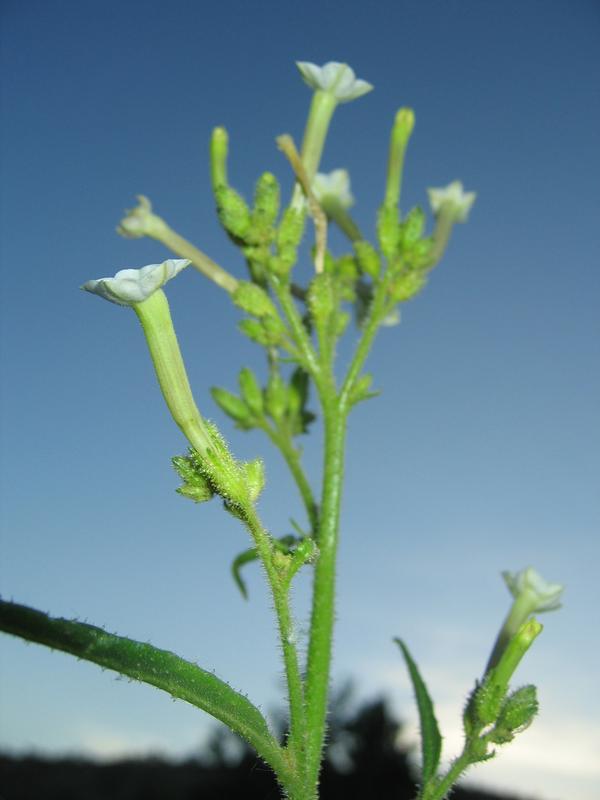Nectar: a sweet reward from plants to attract pollinators

Flowers of wild tobacco Nicotiana attenuata Danny Kessler / Max Planck Institute for Chemical Ecology
To make sure that flying pollinators such as insects, birds and bats come to the flowers to pick up pollen, plants evolved special organs, the nectaries to attract and reward the animals.
Scientists have now identified the sugar transporter that plays a key role in plants’ nectar production. SWEET9 transports sugar into extracellular areas of the nectaries where nectar is secreted. Thus, SWEET9 may have been crucial for the evolution of flowering plants that attract and reward pollinators with sweet nectar.
Flowering plants need sugar transporter SWEET9 for nectar production
Evolution is based on diversity, and sexual reproduction is key to creating a diverse population that secures competitiveness in nature. Plants as largely immobile organisms had to solve a problem: they needed to find ways to spread their genetic material beyond individual flowers. To make sure that flying pollinators such as insects, birds and bats come to the flowers to pick up pollen, plants evolved special organs, the nectaries to attract and reward the animals.
Scientists from the Max Planck Institute for Chemical Ecology in Jena (Germany) and their colleagues from Stanford and Duluth (USA) have identified the sugar transporter that plays a key role in plants’ nectar production. SWEET9 transports sugar into extracellular areas of the nectaries where nectar is secreted. Thus, SWEET9 may have been crucial for the evolution of flowering plants that attract and reward pollinators with sweet nectar. (Nature, March 16, 2014, doi: 10.1038/nature13082)
Despite the obvious importance of nectar, the process by which plants manufacture and secrete it has remained a mystery. New research from a team led by Wolf Frommer, director of the Plant Biology Department, Carnegie Institution for Science in Stanford, in collaboration with the Carter lab in Minnesota and the Baldwin lab at the Max Planck Institute for Chemical Ecology in Jena, Germany, now identified key components of the sugar synthesis and secretion mechanisms. Their work also suggests that the components were recruited for this purpose early during the evolution of flowering plants. Their work is published by Nature.
The team used advanced techniques to search for transporters that could be involved in sugar transport and were present in nectaries. They identified SWEET9 as a key player in three diverse flowering plant species, thale cress Arabidopsis thaliana, turnip Brassica rapa and coyote tobacca Nicotiana attenuata, and demonstrated that it is essential for nectar production.
In specially engineered plants lacking SWEET9, the team found that nectar secretion did not occur but sugars rather accumulated in the stems. They also identified genes necessary for the production of sucrose, which turn out to be also essential for nectar secretion. Taken together, their work shows that sucrose is manufactured in the nectary and then transported into the extracellular space of nectaries by SWEET9. In this interstitial area the sugar is converted into a mixture of sucrose and other sugars, namely glucose and fructose. In the plants tested these three sugars comprise the majority of solutes in the nectar, a prerequisite for collection by bees for honey production.
“SWEETs are key transporters for transporting photosynthates from leaves to seeds and we believe that the nectarial SWEET9 sugar transporter evolved around the time of the formation of the first floral nectaries, and that this process may have been a major step in attracting and rewarding pollinators and thus increasing the genetic diversity of plants,” Frommer said.
Original Publication:
Lin, W., Sosso, D., Chen, L.-Q., Gase, K., Kim, S.-G., Kessler, D., Klinkenberg, P. M., Gorder, M., Hou, B.-H., Qu, X.-Q., Carter, C., Baldwin, I. T., Frommer, W. (2014). Nectar secretion requires sucrose phosphate synthases and the sugar transporter SWEET9. Nature, March 16, 2014, doi: 10.1038/nature13082
http://dx.doi.org/10.1038/nature13082
Further Information:
Wolf Frommer, Carnegie Institution for Science, Stanford CA, USA, Tel. +1 650 325-1521 x208, e-mail wfrommer@carnegiescience.edu
Ian T. Baldwin, Max Planck Institute for Chemical Ecology, Jena, Germany, Tel. +49 3641 57-1100, e-mail: baldwin@ice.mpg.de
Contact and Picture Requests:
Angela Overmeyer M.A., Max Planck Institute for Chemical Ecology, Hans-Knöll-Str. 8, 07743 Jena, +49 3641 57-2110, overmeyer@ice.mpg.de
Download of high-resolution images via http://www.ice.mpg.de/ext/735.html
Media Contact
All latest news from the category: Life Sciences and Chemistry
Articles and reports from the Life Sciences and chemistry area deal with applied and basic research into modern biology, chemistry and human medicine.
Valuable information can be found on a range of life sciences fields including bacteriology, biochemistry, bionics, bioinformatics, biophysics, biotechnology, genetics, geobotany, human biology, marine biology, microbiology, molecular biology, cellular biology, zoology, bioinorganic chemistry, microchemistry and environmental chemistry.
Newest articles

First-of-its-kind study uses remote sensing to monitor plastic debris in rivers and lakes
Remote sensing creates a cost-effective solution to monitoring plastic pollution. A first-of-its-kind study from researchers at the University of Minnesota Twin Cities shows how remote sensing can help monitor and…

Laser-based artificial neuron mimics nerve cell functions at lightning speed
With a processing speed a billion times faster than nature, chip-based laser neuron could help advance AI tasks such as pattern recognition and sequence prediction. Researchers have developed a laser-based…

Optimising the processing of plastic waste
Just one look in the yellow bin reveals a colourful jumble of different types of plastic. However, the purer and more uniform plastic waste is, the easier it is to…



